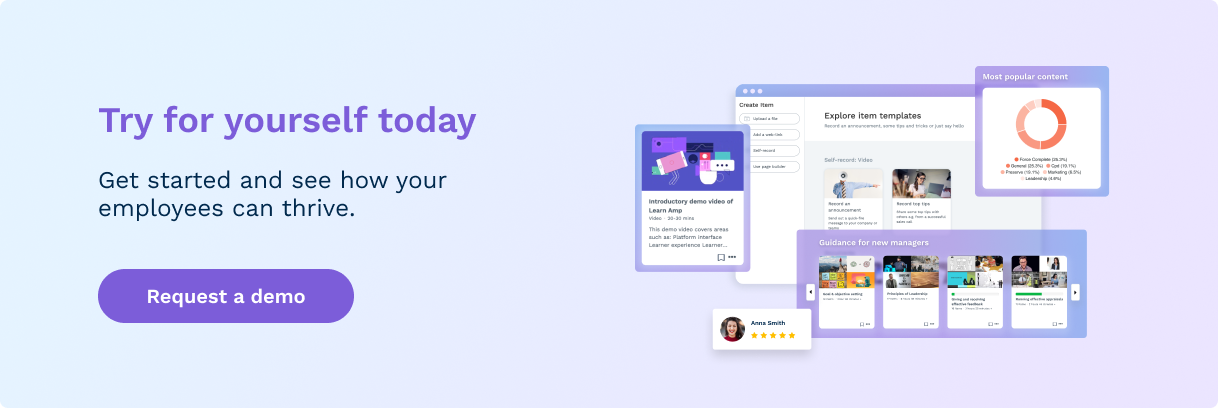So you need a new learning and development platform. You’ve analysed your existing L&D set-up. You’ve identified the gaps. You’ve decided on the types of tools and features you’re looking for. Now it’s time to find a software partner with a set of sustainable solutions to your address your needs. But how can you be sure to find the right vendor that will actually deliver for you?
Make no mistake: selecting a learning and development platform is not just about buying software. It’s also about starting a partnership that will offer your business the support you need to design and deliver the best learning and development experiences for your employees over the years to come.
Here, we’ll help you design a comprehensive selection process to guide you to find the right platform and partner. We’ll look at how to approach each stage: researching the market, contacting vendors, trialing products, longlisting and shortlisting the best options, negotiating your contract and signing off on your new learning and development platform. We’ll also provide you with a killer question bank to ensure you have all the right questions to hand.
A roadmap for selecting a new learning and development platform
Think of your selection process as a roadmap. Each checkpoint along the way is also an exit ramp for those vendors that aren’t meeting your requirements. By the time you reach your destination, the aim is that you’ll have the one vendor left that is the right fellow traveller for your business and your employees.
1. Research the market
-
Create an initial list of prospects by:
-
-
asking for referrals from within your own network
-
looking at the best comparison sites
-
reviewing the rankings from credible systems experts and source
-
-
Do wider research through review sites, forums and industry publications. Evaluate vendors against your criteria. Do they meet your must-haves1?
-
Draw up a list of 10-15 vendors maximum. Study their websites, product lists and reviews. Do they meet your requirements list? Do they feel like the right kind of partner for your company?
Top tip: Avoid time-intensive calls and pitches at this point. Instead, make use of live chats and chatbots to get the information you need. Don’t worry—once the vendor has your contact details, you’ll be sure to hear from them.
2. Longlist vendors to engage directly with
-
Get your initial list down to a longlist of 5-8 vendors to engage with directly.
-
Decide on initial questions you didn’t find answers to in your online research.
 |
Top tip: Don’t just use the same questions for every vendor. Prepare a customised questionnaire and checklist for each vendor, based on your research.
3. Request a discovery call
-
Complete the vendor’s request form with as much detail as you can.
-
Describe how you intend to use the platform, both internally and externally.
-
Provide your requirements list and ask how well they can meet these.
-
Request other key information (ballpark pricing, procurement redlines, implementation procedures) to ensure this is a vendor worth considering.
Top tip: Keep a scorecard assessment for each vendor, recording positives and negatives from the conversations.
4. Deep dive into product demos
-
Based on your scorecard assessments, decide which vendors to request demos with.
-
Set up an initial demo to get a flavour for the platform.
-
Take note of positives and negatives, and use these to whittle down your longlist.
-
Set up further demos, and involve key stakeholders to ensure the platform delivers against all your functional and technical needs.
Top tip: Record sessions, so you can refer back to them and to share with others internally.
5. Road-test the platform
-
Gauge the usability and functionality of the platform from an administration and end-user perspective.
-
Gather feedback from test users.
-
Compile any questions or follow-ups to address with the vendor.
-
Gauge how satisfied you are with the vendor’s responses.
Top tip: Download our killer question bank to make sure you’re asking the right questions and covering all the bases.
6. Create your final shortlist and really get to know them
-
Decide on the top 2-3 vendors you’ve tested
-
Check the credentials and certifications of your shortlisted vendors
-
Contact each vendor and work with them on more refined final commercial proposals. Stay focussed on your requirements. Don’t get distracted by bargain offers or shiny functionality that may not suit your needs
-
Find out about any additional or hidden costs or fees for training, licensing or maintenance
-
Request their legal terms and SLAs to compare against the others
Top tip: If you can, find out what their other customers say. For example:
-
-
How long have they been a customer?
-
How was their launch experience?
-
How effective is the platform in meeting their objectives?
-
How good is the customer service and support experience?
-
7. Secure final decision buy-in
-
Put together a cross-organisational selection team to ensure the relevant voices from HR, Finance, IT and Leadership have input.
-
Explain exactly how the platform will deliver ROI. Keep it simple and use relevant business metrics to demonstrate impact.
-
Leave them with meaningful takeaways. For example, illustrate how the platform will drive employee engagement, and how engagement improves performance, profitability and retention2.
-
Ask vendors to present, demo or meet with stakeholders to talk through any outstanding aspects. Vendors are experts in selling themselves, so use them!
Top tip: When presenting to stakeholders, use examples from their sphere to illustrate how the platform will address their specific motivations and pain points.

|
Get actionable insights around Employee Experience and People Development |
8. Negotiate, prepare your contract and sign on the dotted line
-
Inform your chosen vendor you want to move forward with them
-
Decide on key dates for the contract, such as implementation kick off, contractual go-live date etc.
-
Ask for a draft contract that mirrors the final commercial offer and includes the key dates. Have this reviewed by your legal and commercial leads.
-
Address any final procurement, security or technical concerns.
-
Ask your chosen vendor for more detailed information on the implementation process and what you can do to get ahead.
-
Negotiate where needed. But keep things amicable. Remember: you’re hoping to build a relationship here.
Top tip: Use this period as a readiness period to get prepared for kicking off your implementation.
Once all parties are happy, then sign on the dotted line and start getting excited for implementation!
Make your learning and development platform work for you
When you’re selecting a learning platform that is right for your needs, it’s vital that you are in control of the conversation. Download our killer question bank to make sure that you have all the right question to find the best L&D solution for your business.
Once you’ve selected a platform and a vendor that will really deliver for your business and your employees, the real journey begins. Read our next piece in this series to help you get the most from your new learning and development platform.
Resources
[1] https://elearninfo247.com/2021/03/22/learn-amp-product-review/




